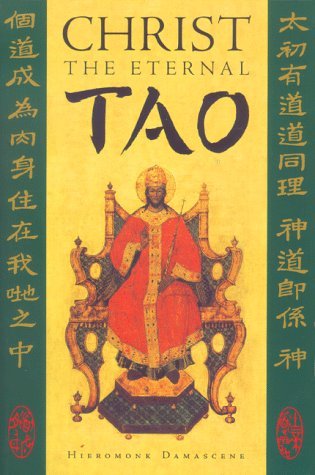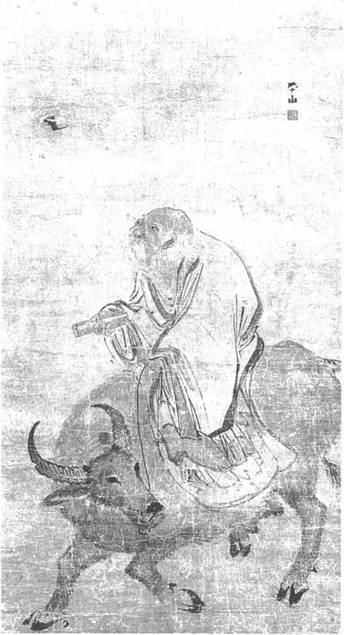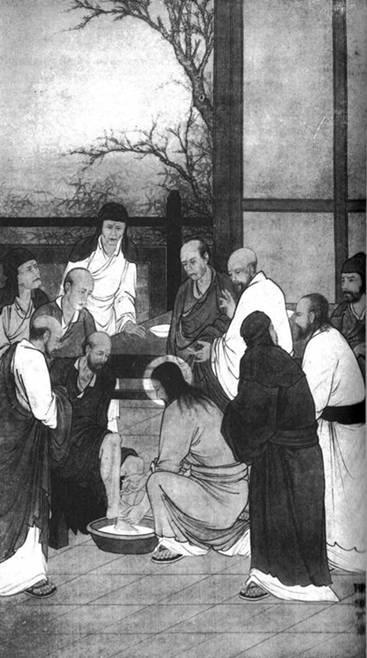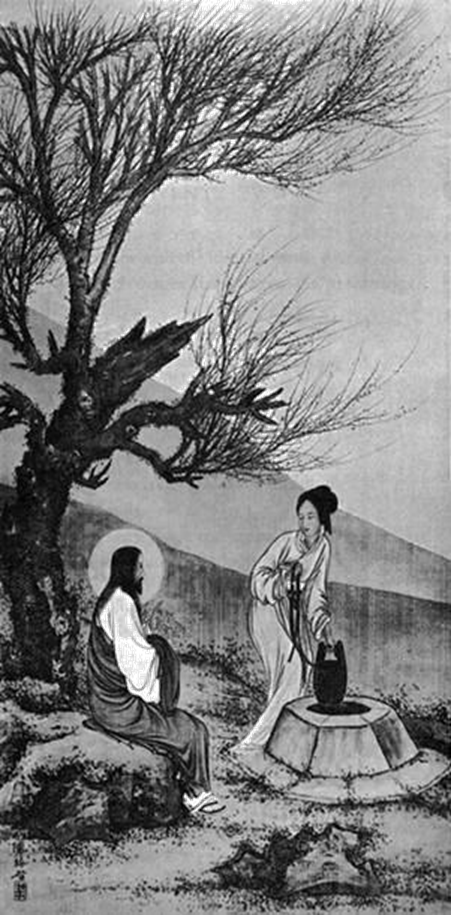![]()

“There exists a Being undifferentiated and complete,
Born before heaven and earth.
Tranquil, boundless,
Abiding alone and changing not,
Encircling everything without exhaustion.
Fathomless, it seems to be the Source of all things.
I do not know its name,
But characterize it as the Tao.”
The Gospel of John begins with one of my favorite passages in Scripture. It poetically emphasizes that the Word of God, Jesus Christ, existed prior to the creation of the universe with God the Father, and, in fact, had a necessary hand in that creation. It also affirms that Jesus did indeed take on flesh and become one of us. It may seem to be reiterating truths that are obvious and uncontroversial to Christians today, but John the Apostle wrote the book in part to clarify misunderstandings about Jesus that were prevalent in his time. Composed decades after the Synoptic Gospels had entered circulation, John’s gospel was written to an audience that didn’t exist when the earlier books were penned—persecuted Christians, scattered and disillusioned after the fall of Jerusalem.
In the beginning was the Word, and the Word was with God, and the Word was God. He was in the beginning with God. All things were made through him, and without him was not any thing made that was made. In him was life, and the life was the light of men. The light shines in the darkness, and the darkness has not overcome it. (John 1:1-5)
At the center of this passage is the Greek word translated as “Word.” That Greek word is “λογος” or logos, a pliable noun that has meant things such as “reason,” “proportion,” “argument,” “discourse.” Pre-Socratic philosopher Heraclitus used logos to mean “a principle of order and knowledge.” Even more specifically, the Stoics considered logos to mean, among other things, “the ordering principle in the cosmos” or “the active reason animating the universe.” Philo of Alexandria, a Hellenized Jew who lived during the time of Jesus, spoke of it thusly: “The Logos of the living God is the bond of everything, holding all things together and binding all the parts, and prevents them from being dissolved and separated”. It’s clear that logos, inadequately translated into English as “word,” had a much deeper meaning and a broader connotation to ancient philosophers and theologians than our modern idea of the word “word.” With a healthy conception of the Logos, then, John’s affirmation a few verses later takes on a new meaning.
And the Logos became flesh and dwelt among us. (John 1:14a)
Looking at it from this angle, the phrase “the Incarnate Logos” takes on greater significance. This new definition is more difficult to comprehend, to be sure, but much better than the watered down alternatives. By understanding Jesus as the embodiment of the underlying pattern upon which space and time are structured, it’s easier to grasp—even if incompletely—how his death and resurrection could have a redemptive effect upon mankind as a whole.
![]()
This conception of Jesus is very different from many of the false ones, old and new, that have been peddled as the truth—the righteous man glorified by God, a man inhabited by the spirit of God at his baptism, an illusionary spirit appearing to look like a man, a good moral teacher but not divine, a prophet, etc. These ideas became so widespread so quickly that John—the only Apostle who was not martyred, and so lived to old age—wrote his late contributions to the biblical canon partially to clarify the truth on this matter. In a nutshell, an understanding of “the Word/Logos of God” is crucial to beginning to comprehend the cosmic sucker punch of the life, death, and resurrection of Jesus Christ.
In Chinese translations of the Gospel of John, logos is translated as “Tao,” another multi-use word that means things like “path,” “doctrine,” “principle.” Ancient Chinese sage Lao Tzu, in his Tao Te Ching, describes the Tao as the natural order of the universe, the path of heaven, the uncreated cause of all things. Hieromonk Damascene (birth name John Christensen), the author of Christ the Eternal Tao, finds the translation to be quite accurate. In fact, he believes the concepts are too similar for mere coincidence. In his view, “the spirit of the times” led unconnected thinkers to conceive of similar ideas at similar times to prepare the world for the physical manifestation of the divine Logos in the form of the Incarnation—Jesus Christ. It is his belief that Lao Tzu represents the epitome of human intuition in this arena; he came as close to comprehending the Logos as was possible without divine revelation.

With that idea in mind, Father Damascene sets about exploring and comparing Christian teachings with those of Taoism. Are they compatible? There is great risk here of the work devolving into syncretism—indeed, that’s the common result when lightweight Christian authors try to bridge the gap between Christianity and other religions—but Christ the Eternal Tao mostly avoids this pitfall.1 Looking specifically at the thoughts and practices of both Christianity and Taoism, Father Damascene posits that both religions are aiming toward the same ultimate reality, even while affirming that Christians have a firmer grasp of it in the form of Christ. But he does not use this fact to condemn Taoism, because its founder could not have known the reality of Christ’s incarnation prior to it. B.C. Taoists could only “know” the Logos through intuition and contemplation. Through careful thought and observation, Lao Tzu posited that the Tao was omnipotent, eternal, unchanging, and the source of everything. Damascene suggests that, even though we have the benefit of living in a time when Christ is known, there is much to be gained from Lao Tzu’s contemplative approach to aligning himself with the Logos—which is a way of life marked by simplicity, selflessness, and service to others.
The book is broken into three primary sections, the first of which is a reworking of Lao Tzu’s Tao Te Ching, making various substitutions and rearrangements to emphasize the similarities between the doctrines of Taoism and Christianity.2 I was initially a little bit skeptical at the idea of this, but it seems pretty solid for the most part. It reads like a collection of Psalms, almost, but covering theological concepts like the trinity and telling the Gospel story—though of course it is not actually Scripture. Here are some samples:
Before the Word came into the world
The sages sought Him out in every place.
They saw Him not, but sensed His presence everywhere.
They found Him in living beings, in mountain crags and flowing streams, in seas and winds.
He was not these things,
But he spoke in these things, guiding them.
All things followed His course.
Therefore the sages called Him by His other name:
The Way (Tao),
The course that all things are to follow.
He willed to be alone as a man
So that man would no longer be alone.
He willed to stand watch as a man
So that man, who preferred to sleep,
Would at last awaken.
The second part is a more thorough analysis of the overlap in Christian and Taoist systems of thought. The thrust of this section is to persuade the reader that the Logos and the Tao that are central to Christianity and Taoism, respectively, are one and the same—and that they are known to us in the form of Jesus Christ of Nazareth. To get us there, Damascene presents a survey of Hebrew prophets, Greek philosophers, Patristics, and historical Orthodox and Catholic writings. He also pulls from Chinese commentaries on the work of Lao Tzu. This section is the meatiest part of the book, tackling difficult questions with integrity, if not academic rigor.

One of the most interesting threads of discussion is the separation of our spirit, soul, and mind. This is not an uncommon sentiment—you are not your thoughts, you may allow them to come and go without acting on them, etc. But Fr. Damascene, by way of Lao Tzu, suggests that if one can hone their skills in this area, so to speak, they can reach a “primal simplicity”—i.e. the pre-Fall state of man—in which mode we will conduct ourselves righteously without having to consider the ramifications of our actions. The good becomes natural, in other words.
If one were to distill Lao Tzu’s teaching on human conduct, it would be simply that one should do what is natural. To be natural, however, one must first find the original nature of man. Acting in accordance with this nature, one acts in accordance with the Tao. Thus one no longer has to be choosing all the time, but can be wholly spontaneous. Being spontaneous, one can forget oneself and give oneself over for the good of others. One will do what is right, not only without having to think about it, but without even knowing it! Such is the state of primal simplicity, before man usurped the “knowledge of good and evil.”
Setting aside discussions on whether or not this is ultimately achievable in this life (we live in post-Fall world, after all), much of the book can be seen as a guide to aligning oneself toward this goal. Discussions abound on the distinctions between aspects of our inner being, and how to exert control over ourselves in effort to achieve this primal state. Damascene’s teachings on this point seem reflective of those of Seraphim Rose, particularly what I imagine the book Genesis, Creation, and Early Man to expound upon (but I haven’t read that book because it regularly fetches over $100 used on Ebay).
The last section, then, leans heavily into practical application, serving as a spiritual transformation guide for the individual. It draws on the shared ideas of Taoism and Christianity, of course, but places most of its emphasis on the mystical practices of Eastern Orthodoxy. Illustrated with recollections from the lives of saints canonized in the Orthodox Church, the prayerful practices elucidated are meant to quell the anxious ego and properly align our spirits toward the Tao/Logos. Seen through Western eyes, there is quite a lot here that is foreign to me, although a lot of it seems to share goals and mechanics with Western Christendom while using different words and analogies,3 even if it occasionally suggests things that most Protestants would simply consider unnecessary and so not worth pursuing. Still, the notion that man needs to rely more heavily on God, and put less stock in ourselves, should be fairly uncontroversial for most Christians.
Though the book very often treads in ancient waters, there are a few sections where Fr. Damascene addresses modern challenges. There was one section in particular that I thought was almost comical in how bluntly the author critiques society (remember this was written all the way back in the 1990s):
In our fast-paced society based on instant gratification, people want spirituality instantly. Caught in a morass of refined sensuality, they seek spirituality in a sensual way. Hypnotized in their false identities, they seek spirituality which only gets them deeper into hypnosis—now with a spiritual veneer. They expect to be comforted in their filth. They cannot go deeper, because they will do anything except face their filth.
Later, he follows up on this by chastising the Christian who pursues spiritual experiences, enlightenment, or peace of mind. He calls these things “egotistic ambitions and another way of escaping from ourselves.” He explains that watchfulness—the state of dispassionately observing one’s thoughts—is a necessary prerequisite for pure prayer, because a mind that is distractedly following thoughts will not be able to pray well. He says, “Watchfulness is not a means of getting what we want; it is a means of knowing what is right. It is not in order to feel better; it is in order to be better.” From the outside, Eastern meditative/contemplative practices can seem sketchy—especially if one comes from a tradition of austerity that is naturally suspicious of New Age mysticism—but Fr. Damascene is clear that it is not a practice to undertake in a willy-nilly fashion. He writes about modern man’s inability to perceive the light of his own soul, and then warns about the potential dangers of unmoored prayerful meditation. He also suggests that the prayer (that is, the one praying) not become discouraged if he does not reach a profound state even after praying regularly for a long time, because our aim is not a certain state but the regular raising of our hearts and minds to God.
Many who have practiced watchfulness have fallen into delusion over the centuries. Everything depends on the purity of one’s intention in going within. If one’s intention is not to face one’s sin-condition, repent and thus be reconciled to God, but instead to “be spiritual” while continuing to worship oneself, then one can—upon becoming aware of the light of one’s spirit—begin to worship it as God. That is the ultimate delusion.
While the aim of the book is the reconciliation of Lao Tzu’s “Tao” with the Christian idea of the Logos, I found that Fr. Damascene’s teachings on the mystical practices of Eastern Orthodoxy really pulled back the curtain for me and showed me just how much of the day-to-day acts of prayer and thoughtful contemplation align with American Protestantism (which would generally condemn mystical practice). It seems more of a disagreement on word choice and description, that we see as a disagreement on fundamentals. But that’s a discussion for a different time, and one I’m not really qualified to make in either direction.

Considering that the goals of the book’s different sections only partially overlap, I can’t help but question their packaging as a single work. I find the discussion of Lao Tzu’s teachings and Christianity to be interesting to read, but it has little bearing on my own life. I would consider it a matter of personal interest. Trying to make a case that Lao Tzu or Socrates or whomever was a follower of the Logos and therefore a proto-Christian is all well and good as an academic exercise, but I’m not going to learn how to be a follower of Christ from Lao Tzu. There are similarities, hence why the book was written, but there are also large differences. It’s a fun subject to mull on, but since we live in a time after the life of Christ, it is basically trivial for the modern believer. So to segue from such a discussion to one of recommending spiritual practices seems needlessly risky, as it could lead to an incorrect conflation of the two religions. I’d go so far as to assume that the average reader of this book will be some flavor of New Age mystic, and that they would not heed Fr. Damascene’s periodic warnings, resulting in some unhealthy spiritual practices. For instance, Lao Tzu’s Tao Te Ching is never considered authoritative; but I could see someone looking to it as such after reading Fr. Damascene’s book.
Having scoured the world’s religions for years, Damascene considered himself a Zen Buddhist when he first heard a lecture given by Father Seraphim Rose, a prominent Orthodox hieromonk and religious scholar, who himself had studied under prominent Lao Tzu scholar Gi-ming Shien (as well as famous British mystic Alan Watts). Rose, also a former Buddhist, took the younger man under his wing and guided him into believing that the truth is not just an abstract concept but a reality that can be experienced. After writing a biography of Fr. Seraphim, Fr. Damascene took on the challenge of analyzing the overlap between the ancient teachings of Lao Tzu that had fascinated both of them, and the Christianity that they had committed their lives to, resulting in Christ the Eternal Tao.
I found the middle section, which was the most analytical, to be the most engaging, but the opening (“The Gospel According to Lao Tzu”) and the latter practical section both had plenty to recommend them by as well, even though I had a few hang-ups with the juxtaposition of comparative analysis and practical application. Christ the Eternal Tao is a different kind of book—it avoids repeating what every Christian has heard a thousand times, it doesn’t shy away from elucidating some of the practices of the Orthodox Church that many Westerners find too mystical, and it tackles an incredibly ambitious subject in trying to reconcile Lao Tzu’s teachings with Christianity. I’m not sure that I could square every little detail or justify every suggested practice, but I’m certainly glad I got my hands on a copy of the book.
1. An interesting topic to ponder is whether God’s grace could have extended to any outside of the Scriptural covenants he made with mankind. Even when Father Damascene comes close to saying that perhaps some of these ancient wise men, disconnected from the culture in which God made himself known to mankind and Christianity was born, may have been granted salvation, I don’t recall him ever saying it outright; although he does quote St. Justin, an early Christian martyr: “Those who lived in accordance with the Logos are Christians, even though they were called godless. […] Those who lived by the Logos, and those who so live now, are Christians, fearless and unperturbed.”
2. I’m not familiar with Lao Tzu’s work. Most of what I know about it is from this book, actually, so I’m just taking it on the word of others that the work presented in this book as “The Gospel According to Lao Tzu” is representative of Lao Tzu’s actual writing.
3. While I believe that most of the practices endorsed here are uncontroversial from an Eastern Orthodox perspective, I can’t personally say that I’ve undertaken them or agree with all of them. Not that I have principled arguments against them; but this is a dense work with untold nuance, and I don’t have the doctrinal acumen to slice and dice it in a manner to determine what’s good and what’s not (if anything); the author clearly demarcates various “levels” of prayer, such that some of the spiritual practices can be undertaken without fear of harm (i.e. only good can come from them), while others can lead to less healthy results if done improperly.
Sources:
“Logos”. The Spiritual Life.